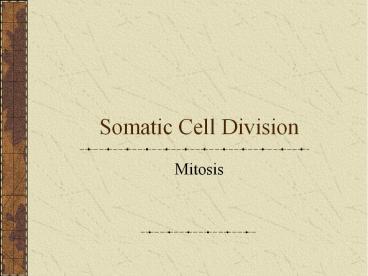Somatic Cell Division - PowerPoint PPT Presentation
1 / 20
Title:
Somatic Cell Division
Description:
Somatic Cell Division Mitosis Somatic Cells All body cells except gametes (sex cells) Somatic Cell Division A cell divides into two identical cells Replaces dead or ... – PowerPoint PPT presentation
Number of Views:337
Avg rating:3.0/5.0
Title: Somatic Cell Division
1
Somatic Cell Division
- Mitosis
2
Somatic Cells
- All body cells except gametes (sex cells)
3
Somatic Cell Division
- A cell divides into two identical cells
- Replaces dead or injured cells
- Adds new cells for tissue growth
4
DNA Replication (Duplication)
- The DNA sequences that make up the chromosomes
have to be copied so the same genetic material
can be passed on to the new cells
5
Cell Cycle
- The sequence of changes a cell undergoes from the
time it forms until the time it duplicates its
contents and divides into 2 cells - Two major time periods
- Interphase not dividing
- Mitotic Phase - dividing
6
(No Transcript)
7
Interphase
- The cell replicates DNA and manufactures
additional cell organelles and cytosolic
components - High metabolic activity
- Most growth
8
DNA Replication
- DNA nucleotides are synthesized in the cytosol
and imported to the nucleus - The helical DNA uncoils and the 2 strands
separate between the base pairs - The exposed base pair on each strand pairs with a
newly synthesized complementary nucleotide - The new DNA strands take shape as chemical bonds
form
9
DNA Replication - continued
- The original DNA molecule has become 2 identical
strands of DNA - Once a cell completes DNA replication, the
mitotic phase can begin.
10
(No Transcript)
11
Mitotic Phase
- Mitosis division of the nucleus
- Cytokinesis division of the cytoplasm
12
Nuclear Division
- The duplicated chromosomes become divided such
that one set ends up in each nucleus - The process is divided into 4 stages
- Prophase, Metaphase, Anaphase and Telophase
- Mitosis is a continuous process and one phase
merges with the next
13
Prophase
- Chromatin fibers condense and shorten into
chromosomes - Each prophase chromosome consists of a pair of
identical double stranded chromatids - Mitotic Spindle is formed by the pericentriolar
material and centrioles are pushed to opposite
sides of the cell - The nucleolus and nuclear envelope break down
14
(No Transcript)
15
Metaphase
- The centromeres of the chromatid pairs are
aligned along the center of the mitotic spindle
this is called the metaphase plate
16
Anaphase
- The centromeres split, separating the chromatid
pair, which move to opposite ends of the cell. - Once separated the chromatids are called
chomosomes.
17
Telophase
- Final stage of mitosis
- Begins when chromosome movement stops
- The chromosomes start to uncoil, a new nuclear
envelope forms, nucleoli appear and the mitotic
spindle breaks up. - TWO nuclei are present and the cell starts to
divide into 2
18
Cytoplasmic Division - cytokinesis
- Division of the cells cytosol and organelles
- Begins in late anaphase/early telophase with the
formation of a cleavage furrow - Cleavage Furrow slight indentation of the
plasma membrane
19
(No Transcript)
20
Checkpoint
- What is the difference between a chromatid and a
chromosome? - In which stage of the cell cycle is the cell
growing? - What are the mitotic phases in order?
- What is a major event in each stage?

